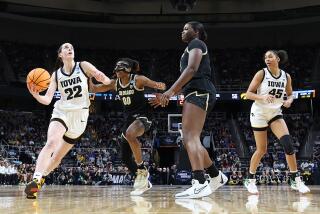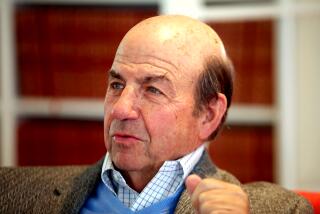Review: A gutsy trio of newswomen in Sheila Weller’s ‘News Sorority’
Why has author Sheila Weller chosen these three particular women as her subjects? Get yourself past that question and you’ll find in “The News Sorority: Diane Sawyer, Katie Couric, Christiane Amanpour — and the (Ongoing, Imperfect, Complicated) Triumph of Women in TV News” a well-reported and refreshingly fair-minded biography of these gutsy and influential newswomen.
Weller, whose previous books include “Girls Like Us,” another that focuses on three prominent women (Carole King, Joni Mitchell and Carly Simon), never really answers the question. What about Barbara Walters, say, or Jane Pauley or Connie Chung? These women and various others do figure in the book. Indeed, one of the charms of “The News Sorority” is that it provides a cursory history of female pioneers in television, including a delightful tidbit about one Martha Rountree, “who turned radio’s The American Mercury, which she had created, into TV’s Meet the Press in the medium’s infancy: 1947.”
When Weller tries to tell us in the introduction what unites her three subjects, including “their strength of character and their resilience,” it feels like an uncomfortable reach. But she finds her footing when she launches into their childhood stories. It soon becomes clear that what unites these women is deeply compelling personal histories, careers filled with glorious triumphs and painful failures — and a boatload of tenacity. Evidently, Weller is a fan of the three she has chosen. But she gives us plenty of material with which to form our own assessment.
Given the complexity of the subject matter, the remarkable thing is that Weller has produced a book that manages to be both compelling and resolutely evenhanded. Even when the catnip of rivalry raises its hoary head, Weller chooses balance. There are lots of controversies, but they usually come along with opposing opinions from different observers and in a broader context. If Walters was “wounded” by Sawyer’s smooth and seemingly unstoppable rise, an ABC colleague points out that “the men were worse,” citing the insufferable imperiousness and condescension of Ted Koppel and Peter Jennings.
It’s hard to write about sexism, yet Weller does it well. In this book, when someone calls someone ambitious, it’s as likely to be a friend as an enemy talking. And those go-to descriptors for successful women — “shrill,” “strident,” “pushy” — are happily scarce.
What the reader does get is plenty of detail, some of which has gotten advance attention, including a crude potshot from Couric to Sawyer over their competition for “gets,” which Couric must deeply regret. Not to mention details about Amanpour’s love life before she married former U.S. State Department spokesman Jamie Rubin or Couric’s youthful struggle with bulimia. Most of the book, though, focuses on the work these women have done and the challenges constantly confronting them as they pioneered their way along.
One recurring irritant is Weller’s effort, especially annoying in the introduction but laced throughout, to force these individuals into nutshells. How many times can Sawyer be called “creamy” or Couric’s “girl next door” qualities noted? Fortunately, these banalities are outnumbered by the defter moments in Weller’s storytelling. And her segues — a common pitfall for writers reaching for cleverness — often delight. That’s a particularly good thing, given the book’s regular leaps from one woman to the other to the other and back again.
But it’s the reporting that makes this story sail. Thanks to photographer David Rust’s riveting diaries of his years with Amanpour in Bosnia-Herzegovina, to Pauley’s honest and open reflections on the challenges facing women in broadcasting and to countless other unusually rich sources, Weller’s narrative is detailed, colorful, fast-paced and authentic-feeling.
From the comical chaos of CNN’s first newsroom to the electrifying tension of war reporting, we see the fruits of a truly formidable source list. Indeed, at times, “The News Sorority” can seem a bit like one of Bob Woodward’s books (except with attribution): a voluminous compilation of events, facts, conversations, lacking illuminating inferences.
But Weller attempts to go further. Having succeeded in presenting portraits of three remarkable women, flawed, full of grit, all dogged reporters, all capable of exceptional grace under pressure, she reaches at the end for something else. Her subjects’ journeys, she says, represent something beyond their individual experiences.
“All three of these women modeled a reality of success that was in many ways different from past models. The more powerful they became, the more interested in people they became… Whatever their idiosyncrasies, whatever their egos, whatever their aggressiveness and ambition, they retained an experienced kernel of humbling reality and it controlled their choices and their consciences.”
While Weller makes clear that all three have repeatedly pursued stories about women and children and about social justice in general, this conclusion seems — like her beginning — a bit of a reach. Maybe these three have just been remarkable women in an often unwelcoming world, living lives that have given countless girls the notion that they might do the same.
Overholser, former director of the USC Annenberg School of Journalism, has worked for the New York Times and the Washington Post and was editor of the Des Moines Register. She is now an independent journalist in New York City.
The News Sorority
Diane Sawyer, Katie Couric, Christiane Amanpour — and the (Ongoing, Imperfect, Complicated) Triumph of Women in TV News
Sheila Weller
Penguin Press: 483 pp., $29.95
More to Read
Sign up for our Book Club newsletter
Get the latest news, events and more from the Los Angeles Times Book Club, and help us get L.A. reading and talking.
You may occasionally receive promotional content from the Los Angeles Times.






